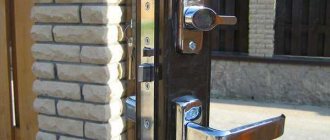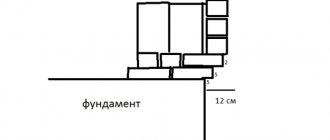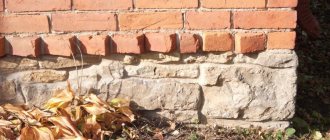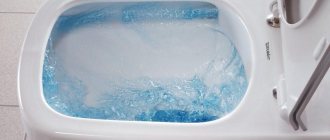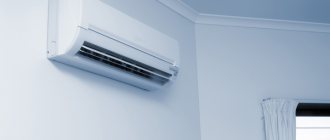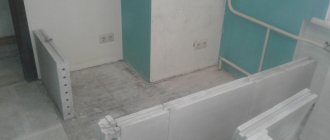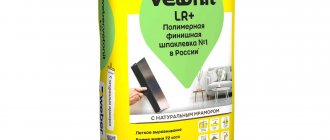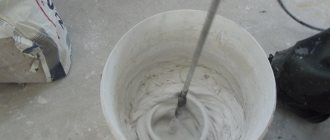Vetonit finishing putty has unique properties. The basis of the putty is fine limestone and ideally selected plasticizers.
Polymer plasticizers improve the following properties of the material: plasticity, adhesion, smoothness, strength, resistance to cracking.
Finishing putty Vetonit
The uniqueness of the Vetonit finishing putty is that the finished solution has the property of not drying out for a long time, this allows you to paint the required amount of the mixture in the desired shade.
Vetonit putty is a series of finishing mixtures for finishing wall and ceiling surfaces, plasterboard partitions. The main use of putty is interior finishing work before painting walls and wallpapering. Finishing putty Vetonit is also available for exterior use.
Material Specifications
The technical characteristics of the putty have their own characteristics for different series of Vetonit mixtures, which depend on the composition of the mixture and the nature of the construction work.
Ready putty
General characteristics for mixtures from the manufacturer Weber:
- white;
- non-waterproof;
- fine limestone;
- grinding - 0.3 mm;
- temperature for working with the mixture - not lower than +10 °C;
- the water temperature during the preparation of the solution is not higher than +40 ° C;
- period of use of the finished mixture - within 24 hours from the moment of mixing with water;
- the mixture must dry within 24 hours from the moment of application to the surface at +20 °C (48 hours at a temperature of +10 °C);
- the layer of putty applied at a time is no more than 5 mm;
- average mixture consumption for a layer 1 mm thick is 1.2 kg/m²;
- adhesion to concrete - 0.5 MPa;
- packaging in bags of 5 and 25 kg.
Dry mixes
Vetonit dry mixtures
Vetonit is the general name for dry building mixtures, the production of which was launched in Europe in the middle of the last century and since then has occupied a strong place in the market of building finishing materials.
It first appeared in Russia about 15 years ago and immediately gained enormous popularity among professional builders, thanks to its excellent technical and operational characteristics. Today, under the Vetonit brand you can find leveling and self-leveling mixtures, tile adhesives, putties and plasters, etc. Each of these building mixtures, depending on its purpose, differs in composition and characteristics, which is reflected by the marking of vetonite. The following grades of vetonite are most often used during repair and construction work.
Vetonit TT is a moisture-resistant dry mixture that is used to level walls or ceilings in rooms with high humidity, such as, for example, a bathroom. Vetonit EP plaster is recommended for dry rooms. These brands of putties are distinguished by excellent adhesive ability (ability to adhere to the main surface) when applied to concrete, brick or plaster surfaces, as well as strength and elasticity.
To level the floor in a room for any purpose (both industrial and domestic), Vetonit 1000, 3000, 4000, 5000, 6000 is used. This brand is a self-leveling dry cement-based mortar that can be applied either manually or poured using pump The digital designation in the marking of this type of dry mixture indicates the maximum thickness of the layer with which it can be laid.
Vetonite KR and LR have excellent performance in finishing walls and ceilings. This product is an adhesive-based putty. When leveling the surface using such a mixture, due to the very fine structure of the mixture, a perfectly flat and smooth wall or ceiling is obtained. The surface obtained as a result of finishing leveling is of such high quality that it can be either not subjected to further painting or whitewashing, or by painting it with ordinary acrylic paint, you can obtain a mirror surface.
For rooms with high humidity, a waterproof putty Vetonit VH (VH) has been developed. This finishing putty is available in a variety of colors and is intended for decorative finishing of both building facades and interior elements.
We should not forget that vetonite will become a reliable assistant in construction or repair if the instructions for use are strictly followed. These dry mixtures are sold in 25 kg bags with markings. They should be stored in a dry room (humidity no more than 90%) on wooden flooring at a room temperature of at least 10 degrees. By using Vetonite in strict accordance with the instructions, you will get perfectly even and smooth walls, spending a minimum of money and effort.
Rotband dry mixes
Rotband is a dry construction mixture based on gypsum with additives to ensure maximum adhesion to the surfaces on which plaster is applied. One of the advantages of rotband plaster is the low coefficient of sound and thermal conductivity, which is provided by the gypsum base. In addition, as is known, gypsum has the ability to absorb moisture when air humidity is high, and release excess moisture when the air is excessively dry. Therefore, in rooms where Rotband plaster was used there is always an optimal microclimate, which is very important for residential buildings and office premises. A very important quality of this plaster mixture is its non-shrinkability, which allows you to apply a layer with a thickness of 5 to 50 mm when leveling.
The low specific gravity of rotband plaster compared to cement mixtures and increased adhesive properties make it indispensable for leveling not only walls, but also ceilings. Once again I would like to emphasize that if you want to get perfectly even and smooth walls and at the same time forget about major repairs for a long time, then when choosing any building material, be it vetonite, rotband or plasterboard , you should buy products from famous, world-famous manufacturers, such as , for example, "TIGI Knauf" (Knauf). The Knauf company has been producing construction products of the highest quality for many years.
Founded in 1932 in Germany by two brothers, mining engineers Alfons Knauf and Karl Knauf, Knauf remains a quality leader to this day. In 1990, in Russia, with the support of the main German company Knauf, the first plant for the production of plasterboard systems appeared - Closed Joint Stock Company Tigi Knauf - a plant for thermal, sound-insulating and gypsum products. TIGI products are known almost throughout the world and represent the ideal of quality construction products.
Returning to rotband plaster mixtures, we note the following features of their use. To obtain the best quality of the leveled surface, it is very important to take into account its material and humidity. To avoid uneven setting when plastering walls made of silicate and ceramic bricks, or gypsum fiber (that is, highly absorbent surfaces), it is recommended to pre-prime the wall with a deep penetration primer. If the surface poorly absorbs moisture (for example, concrete or cement), then to achieve maximum adhesion of the rotband plaster to the surface, use primers such as “Betonokontakt” or others with similar characteristics.
Using rotband plaster, you can obtain a surface both for subsequent wallpapering and for further painting. Rotband gives a great effect if used as textured plaster.
The conditions for storing and selling the Rotband plaster mixture are the same as for Vetonite: it is sold in bags (30 kg). It is recommended to store it in dry rooms on wooden pallets; the shelf life of packaged dry Rotband construction mixture is 6 months.
Comparison of characteristics of building mixtures
Knauf Finish putty is used for finishing walls for painting and wallpaper in rooms where there is no high humidity. This type of finish is not suitable for use in bathrooms and kitchens. Another important difference: Knauf HP Finish putty is made of gypsum. The prepared composition must be used within 15 minutes. Packaging Knauf Finish - paper bags of 25 kg.
Advantages: Knauf gypsum putty has a low price, lower consumption, only 0.9 kg/m², when used, you get even and smooth surfaces of high strength.
Disadvantages - short period of use, the presence of large particles in the mixture, which makes it difficult to work with, and difficulty in selecting the required shade.
Putty Knauf finish
Finishing drywall putty is often carried out with Hercules mixture. The mixture is also used in the process of leveling the surfaces of walls, concrete bases after plastering, minor irregularities, and for finishing gypsum and gypsum fiber boards.
Hercules putty is waterproof, white, operating temperature - +5-35 °C. It is used both inside and outside buildings. You can finish the walls, ceiling or facade. The main binding component of the mixture is gypsum. The elasticity of the composition is provided by polymer modifiers.
Finishing putty Hercules is packaged in bags with a capacity of 5, 8 and 20 kg. An important difference between this material is its non-shrinkability; the layer of Hercules putty during hardening does not decrease due to the evaporation of water, but remains the same thickness as when applied to the surface. The mixture has good adhesion to any mineral surfaces. The prepared solution must be worked out within 2 hours.
Rotband putty is available in two types: Rotband-finish and Rotband-paste. The use of Rotband dry mixtures allows you to obtain durable, smooth and light-colored surfaces for finishing decorative work. Rotband Finish putty is more popular than Rotband paste. It smoothes out deep cracks in plaster, unevenness and chipped surfaces of plaster, concrete or brick.
Rotband finish
The composition of Rotband Finish has grain grinding and good adhesion. The material is economical, highly elastic and quick-drying. The working temperature of the solution is not lower than +5 °C. Before applying putty, it is necessary to prepare the surface. The prepared solution must be produced within 2 hours. Rotband contains gypsum binder with mineral filler and polymer additives. The mixture is packaged in paper bags of 20 and 25 kg.
Shitrok putty consists of vinyl fibers as a binder. Its difference from other putties is that the mixture is ready for use, as it is mixed until smooth and has a creamy color. Sheetrock mixture is characterized by good adhesion and resistance to cracking. Vinyl fibers adhere well and smooth the surfaces being treated.
Sheetrock putty is applied manually and can be applied mechanically. The solution consumption is 06-07 kg/m². The quick-drying mixture dries within 5 hours at optimal temperature conditions and standard air humidity.
Ready putty “Sheetrock”
A distinctive feature of Sheetrock putty is its oily structure.
Freezing and thawing do not affect the technical characteristics of the mixture. Packaging of the material: plastic buckets of 5-28 kg.
Prospector Finish putty is used in all weather conditions, dries quickly, at an optimal temperature of +15-20 ° C it takes 24 hours. Prospector dry putty has a wide range and is environmentally friendly.
Works well with concrete, brickwork, plaster. Packaged in paper bags of 12, 18, 20 kg. The basis of the mixture is gypsum and foreign-made modifiers. “Prospectors” are characterized by high plasticity and form perfectly smooth surfaces.
Before applying the putty, the surfaces to be treated are thoroughly cleaned of dirt and dust. Operating temperature: not lower than +10 °C.
Finishing putty Prospectors
Knauf Rotband Finish problems when using
Good day to all. A question like this: all my life I have worked in finishing as a putty for wallpaper - Vetonit LR, for painting Sheetrock. All these years they suited me, so there was no particular need to look for alternative materials.
At the moment I came across a facility where the customer himself dictates the technology for the work. Namely, he needs walls to be painted. We have a private house with about 15 medium-sized residential rooms (the square footage was not calculated due to the payment agreement per room). The frame of the house is aerated concrete blocks, the façade is 15 cm of polystyrene foam.
Inside, the team before us plastered the walls with Knauf Start, then putty over Knauf XP Finish and at this stage everything was abandoned. The customer had already purchased the above-mentioned Knauf Rotband Finish in large quantities and therefore decided to work at their request. When we entered the site, the house was not heated (but the average temperature was above zero).
When work began, the heating was turned on. Further process of work: gypsum board boxes are assembled in the rooms, the center of the ceiling is plaster.
The walls are primed and after 3 hours, ~1 mm thick Knauf Rotband Finish is applied to two or three layers with a difference of 24 hours between layers. Around the 5th day, the ceiling is also puttied into two layers. And now the fun part.
Two and a half months have passed since the first room was puttied.
Walls, ceiling (plastered part of it) and gypsum board BOX!!! The color of the putty is mostly yellow with white spots and gaps. It's like the putty hasn't dried yet.
We begin sanding with an orbital sander with 80-grit paper sandpaper (a common procedure in our team). The sandpaper immediately becomes clogged, the machine gets stuck, and sanding does not occur. The putty is really damp!!! The humidity in the room is extremely low, the windows are dry and do not sweat. It's warm at home.
The only place where the putty is uniformly white and, I suspect, is completely dry is on the ceiling in one of the rooms where the ceiling is made of gypsum plasterboard and puttied only once - so around a 500-watt light bulb there is a dry white spot with a radius of 1.5 meters.
Question for everyone - who worked with Knauf Rotband Finish? What are its properties? Why does it take so long to dry? Could this problem have been contributed to by the fact that in some places the walls in the rooms were visually trimmed to the standard with Rotaband plaster with a layer of 3-5-7 mm and Rotaband was not allowed to dry completely - they putty on top a day later.
If this is the reason, why are there raw gypsum plasterboard boxes on the ceiling, the putty of which was carried out directly on top of the gypsum plasterboard? Why is the putty damp even in those places where putty was applied to a dry, long-dried surface?
I look forward to your answers and advice. Thank you.

